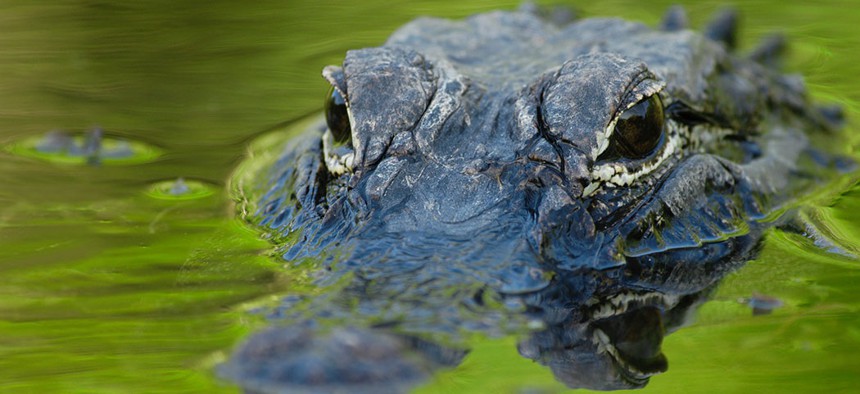A certain population in New York City has been booming in recent years, and it’s not your everyday homo sapiens. Coyotes, bald eagles, white-tailed deer and other animals are finding places to thrive amid the hustle and bustle of one of the most man-made landscapes on Earth.
Some, such as red-tailed hawks and black bears, are trying to reclaim the ecological niches they lost years ago after the first Europeans arrived in the area and spoiled this mid-Atlantic Garden of Eden. Other species, like coyotes and opossums, are taking advantage of the opportunities created by urban areas. “It’s not a bad thing for wildlife to live in New York City,” said Paul Curtis, a wildlife expert in the Department of Natural Resources at Cornell University. “But these are wild animals and we’ve got to respect that.” That means recognizing that New York City is no longer just a place for people and their pampered pets.
Here are the species surviving among the skyscrapers.
Coyotes
“Looney Toons” drastically understates just how wily coyotes are. Originally from the Great Plains, coyotes have taken over the ecological niche left by the virtual extinction of wolves, which once roamed most of the United States, including New York City. Now coyotes are permanent residents of the Bronx and have been seen hitting the bar scene in Long Island City, Queens. The omnivorous canine loves to munch on garbage and has a unique ability to adapt to its surroundings – whether that means hunting for rats in Harlem or finding a sweet nook to sleep along the Hudson. They are not looking for trouble, but they have been known to attack small children and animals, so don’t trust your pets with these heartland upstarts.
White-tailed deer
The feud between New York City Mayor Bill de Blasio and Gov. Andrew Cuomo inadvertently killed Lefty, the Harlem deer, but his kind still have a chance elsewhere in the city – especially in the Bronx and southern Staten Island. They have gotten so numerous in these areas that the city came up with a plan to sterilize many of them. If a proposed bow hunt on Staten Island ever happens, then residents of the “Forgotten Borough” can finally feel that they really are more like middle America than midtown.
Alligators
Despite urban legends about a self-sufficient population of sewer alligators, the only way alligator mississippiensis get into the Big Apple is likely because someone brought them here as a pet. What is surprising, then, is how generation after generation of New Yorkers still think buying alligators is a good idea. And while it might end up badly for the human, it usually ends up even worse for the alligator. One unlucky beast roaming the sewers was beaten to death in 1935 by people wielding snow shovels. In recent years, alligators have tended to pop up in Queens, with sightings in Fort Tilden, Flushing Meadows and under a car in Astoria. They even appear to be spreading out into Long Island.
Red-tailed hawks
The high-flying raptors are thriving in Manhattan, in part thanks to a seemingly never-ending supply of rats and pigeons. These efforts have not gone unnoticed by the people of Gotham, some of whom follow the lives of red-tailed hawks with the fervor of celebrity groupies. But living in the city isn’t all fun and games for the hawks, who face significant dangers from ingesting poisoned vermin and the perils of flying around a city filled with glass buildings. Luckily, they’ve got at least one state senator on their side.
Opossums
North America’s only marsupial began moving into the city about 100 years ago as its range expanded with human settlement. Opossums look like an ill-fated cross between a rat and a kangaroo, and have the street smarts and punch to match. They will gnash their teeth and claws, play dead or even give off a stinky mucus to dissuade predators from attacking. The results are clear. No New Yorker in their right mind wants a taste of an opossum – literally or otherwise – so we leave them to the garbage with minimal screaming.
Gray squirrels
While native to the area, deforestation virtually wiped out the native squirrel populations of New York City by the mid-1800s. Luckily, Victorian-era parkgoers wanted to see the critters roam around the newly created Central Park. You could say that the city was a victim of its own success. Millions of the little critters now live throughout the city, and while humans and squirrels have learned to mostly coexist, there have been occasional purges to lower the population of the rodents. Every now and again, squirrels find their own ways to fight back, like the two occasions when they messed with power lines and shut down the Nasdaq Stock Market.
Black bears
If you are afraid of bears, now might be the time to move away from New York City. Bears are moving through the Hudson Valley and showing up in New Jersey, just miles away from Manhattan. The bottom line is that the bear population is growing, and when they cannot get enough food in the forest, they will go elsewhere. A dead cub was even found in Central Park in 2014, and there could be more coming in his wake, so watch out for any angry mama bears.
Sasquatch
There is no guarantee that the Prospect Park Bigfoot will reappear anytime soon – the bipedal cryptid might not even exist. However, assuming that the Brooklyn Paper has its facts in order, the next snowstorm could allow Brooklyn to become a top destination once more for America’s top Bigfoot hunters. Some wild animals may be too dangerous to take in, but the experience of the Henderson family suggests otherwise.


